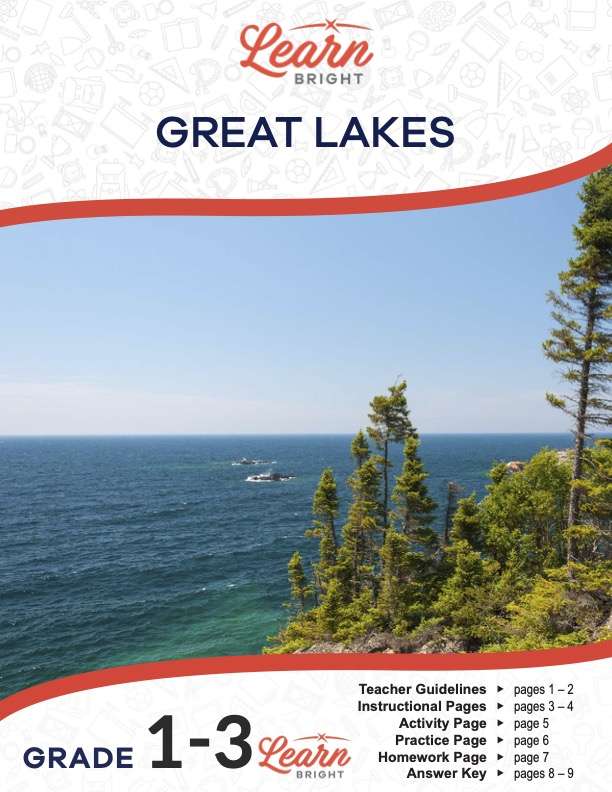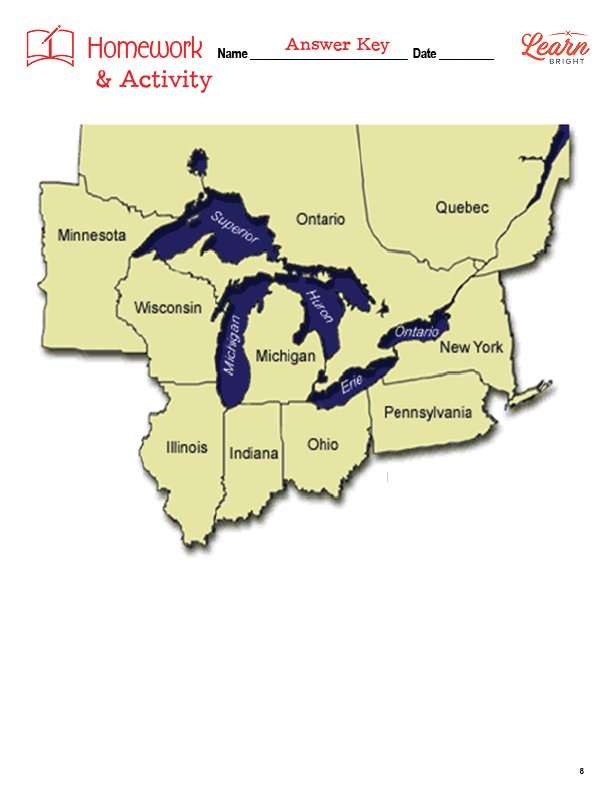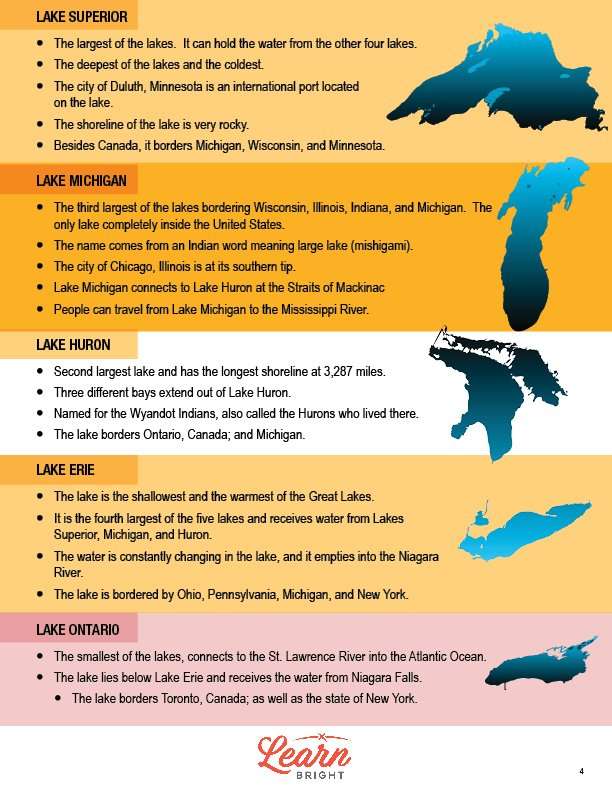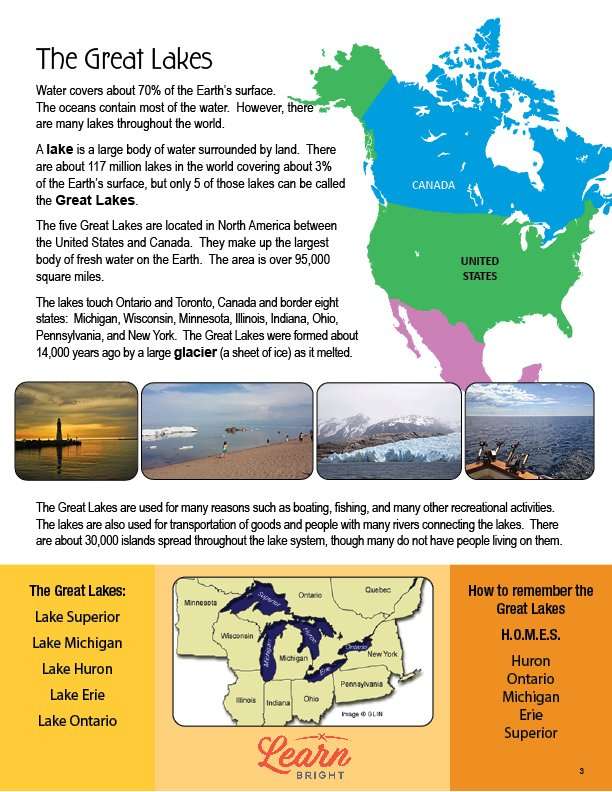Description
What our Great Lakes lesson plan includes
Lesson Objectives and Overview: Great Lakes introduces students to the Great Lakes and provides them with interactive practice to identify and learn some facts about the Great Lakes. At the end of the lesson, students will be able to identify and list some facts about the Great Lakes. This lesson is for students in 1st grade, 2nd grade, and 3rd grade.
Classroom Procedure
Every lesson plan provides you with a classroom procedure page that outlines a step-by-step guide to follow. You do not have to follow the guide exactly. The guide helps you organize the lesson and details when to hand out worksheets. It also lists information in the orange box that you might find useful. You will find the lesson objectives, state standards, and number of class sessions the lesson should take to complete in this area. In addition, it describes the supplies you will need as well as what and how you need to prepare beforehand.
Options for Lesson
Included with this lesson is an “Options for Lesson” section that lists a number of suggestions for activities to add to the lesson or substitutions for the ones already in the lesson. If you have older students, you can assign each student a different lake to research and present to the class. You could also combine this lesson with a lesson on the 50 states. If you want, you can use the practice page as a homework assignment and the homework assignment as an in-class practice page. Finally, you can compare other bodies of water with lakes, like ponds, rivers, and streams.
Teacher Notes
The teacher notes page includes a paragraph with additional guidelines and things to think about as you begin to plan your lesson. This page also includes lines that you can use to add your own notes as you’re preparing for this lesson.
GREAT LAKES LESSON PLAN CONENT PAGES
The Great Lakes
The Great Lakes lesson plan includes two content pages. The lesson begins by stating that water covers about 70% of the Earth’s surface, most in oceans. However, we also have many lakes all over the world. Lakes are large bodies of water surrounded by land. We have about 117 million lakes on Earth, which cover roughly 3% of the Earth’s surface. We call five of these lakes the Great Lakes.
The Great Lakes are in North America, between the United States and Canada. Together, they are the largest body of fresh water on the planet at over 95,000 square miles. These lakes border Ontario and Toronto, Canada and eight states: Michigan, Wisconsin, Minnesota, Illinois, Indiana, Ohio, Pennsylvania, and New York. The Great Lakes formed about 14,000 years ago by a melting glacier.
Today, we use the Great Lakes for many different activities, like boating, fishing, and more. We also use them to transport goods and people using the rivers that connect them. This lake system includes around 30,000 islands, many of which don’t have people living on them.
The Great Lakes are Lake Superior, Lake Michigan, Lake Huron, Lake Erie, and Lake Ontario. You can remember the Great Lakes using the acronym HOMES: Huron, Ontario, Michigan, Erie, and Superior.
The Great Lakes
Lake Superior is the largest, deepest, and coldest of the Great Lakes. It can hold all of the water from the other lakes combined. Duluth, Minnesota, an international port, is on this lake. Its shoreline is rocky and it borders Canada, Michigan, Wisconsin, and Minnesota.
Lake Michigan is the third largest of the Great Lakes. It borders Wisconsin, Illinois, Indiana, and Michigan, making it the only Great Lake completely inside the United States. Its name comes from the Indian word for large lake, mishigami. You can find Chicago, Illinois at its southern tip. It connects to Lake Huron at the Straits of Mackinac. You can travel from Lake Michigan to the Mississippi River.
Lake Huron is the second largest lake and has the longest shoreline (3,287 miles). Three bays extend out from it. Its name comes from the Wyandot Indians who we also call the Hurons. It borders Ontario, Canada and Michigan.
Lake Erie is the shallowest and warmest Great Lake. It’s the fourth largest lake and receives water from Lake Superior, Michigan, and Huron. The water in this lake constantly changes and empties into the Niagara River. It borders Ohio, Pennsylvania, Michigan, and New York.
Lake Ontario is the smallest lake and connects to the St. Lawrence River to the Atlantic Ocean. You can find it below Lake Erie. It gets some of its water from Niagara Falls and borders Toronto, Canada and New York.
GREAT LAKES LESSON PLAN WORKSHEETS
The Great Lakes lesson plan includes three worksheets: an activity worksheet, a practice worksheet, and a homework assignment. You can refer to the guide on the classroom procedure page to determine when to hand out each worksheet.
LABEL THE LAKES ACTIVITY WORKSHEET
For the activity worksheet, students will label and shade each lake. They will also draw and label the bordering states and Canada.
GREAT LAKES FACTS PRACTICE WORKSHEET
The practice worksheet asks students to match the fact with the correct Great Lake.
GREAT LAKES HOMEWORK ASSIGNMENT
For the homework assignment, students will label each lake, bordering state, and Canada on the map. They will also list all of the Great Lakes along with one fact about each of them.
Worksheet Answer Keys
This lesson plan includes answer keys for the practice worksheet, and the homework assignment. If you choose to administer the lesson pages to your students via PDF, you will need to save a new file that omits these pages. Otherwise, you can simply print out the applicable pages and keep these as reference for yourself when grading assignments.









